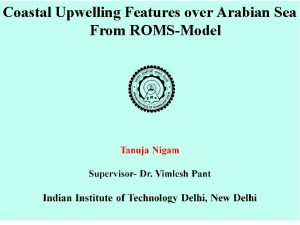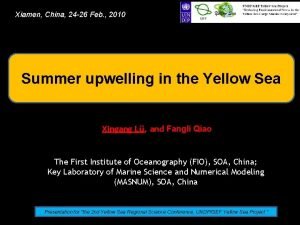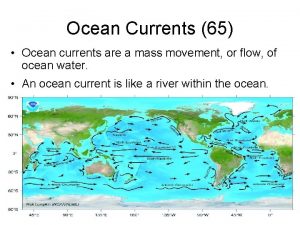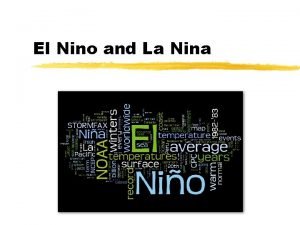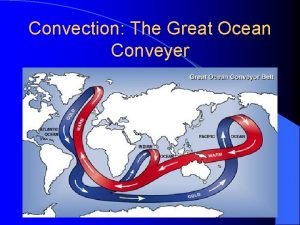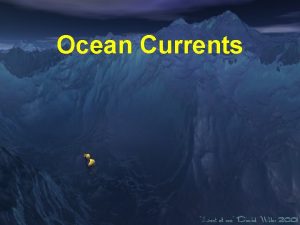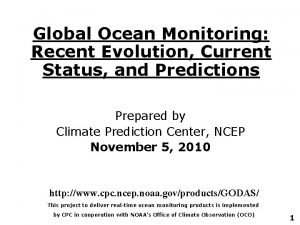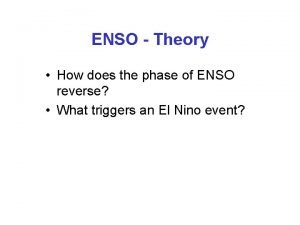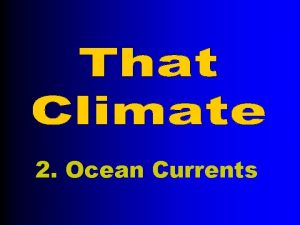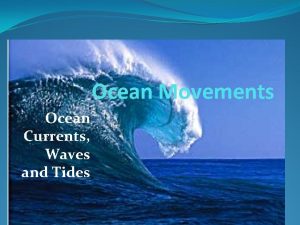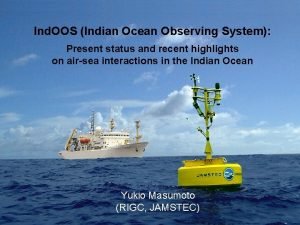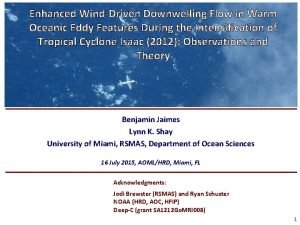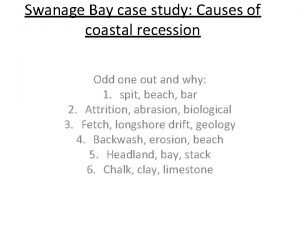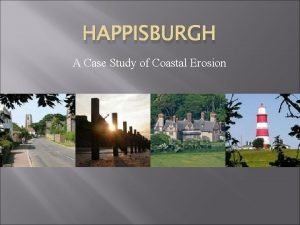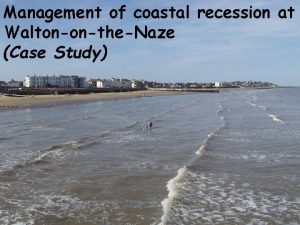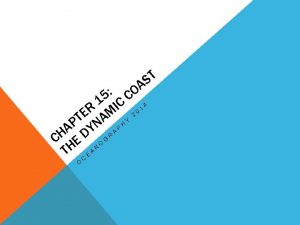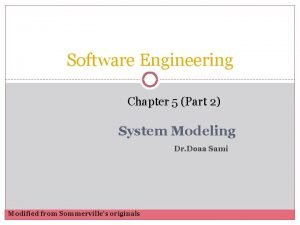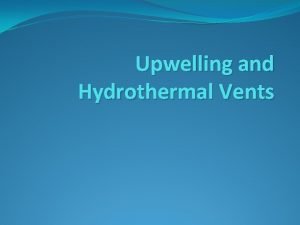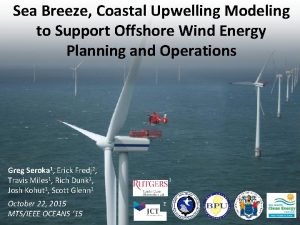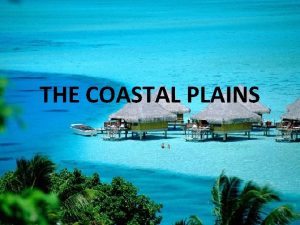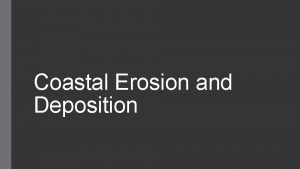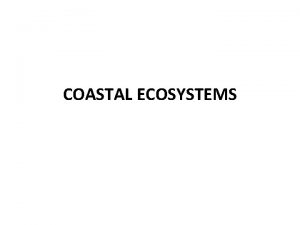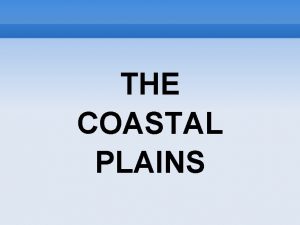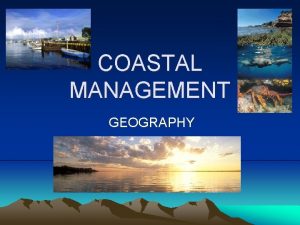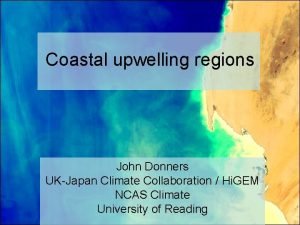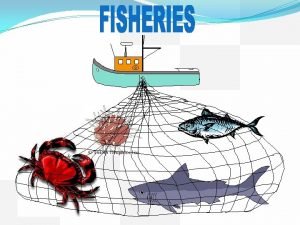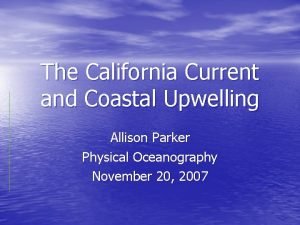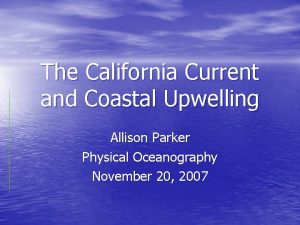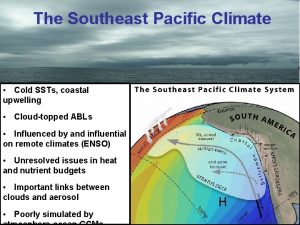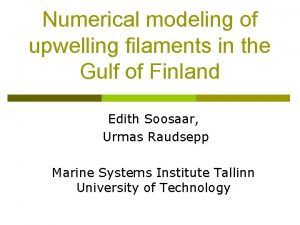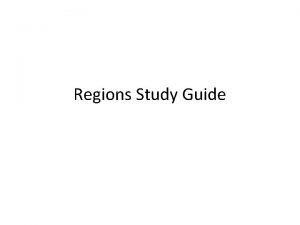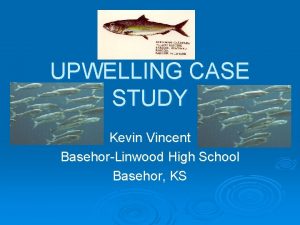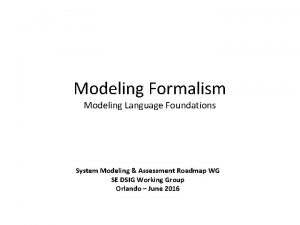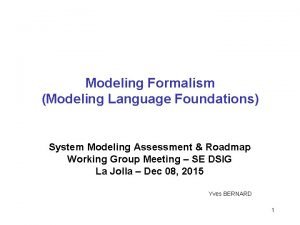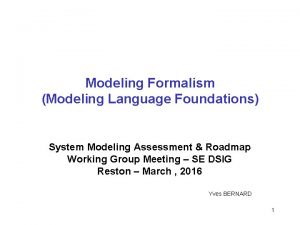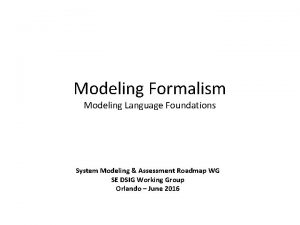Modeling study of the coastal upwelling system of

























- Slides: 25

Modeling study of the coastal upwelling system of the Monterey Bay area during 1999 and 2000. I. Shulman (1), J. D. Paduan (2), L. K. Rosenfeld (2), S. R. Ramp (2), J. C. Kindle (1) Naval Research Laboratory, Stennis Space Center, MS (2) Naval Postgraduate School, Monterey, CA SUPPORT: NOPP “Innovative Coastal-Ocean Observing Network (ICON)” ONR Ocean Modeling and Prediction ONR Biological and Chemical Oceanography

OUTLINE • Physical Model Configuration • Model Validation and Related Issues • Data Assimilation • Conclusions and Future Plans

Hierarchy of different resolution models in the Pacific Ocean. Provides large-scale, basin-scale and small-scale view on the Monterey Bay circulation. Global (NLOM or NCOM) PWC (POM or NCOM)

ICON MODEL • Grid resolution ~ 1 -4 km, 30 vertical • Open boundary conditions are derived from Pacific West Coast (PWC) NRL model (resolution ~10 km). • Atmospheric forcing from NOGAPS and COAMPS predictions. • Assimilation of CODAR data. M 2 M 1 M 3 M 4

Observed and ICON model SSTs August 31, 1999 Santa Crus Pt. Sur


Impact of high-resolution wind forcing on ICON model predictions

PWC and ICON forced with ~90 km wind (NOGAPS)

ICON forced with 9 km wind ( COAMPS) PWC forced with ~ 90 km wind (NOGAPS)

ICON forced with 9 km wind (COAMPS) PWC forced with 27 km wind (COAMPS)

Standard Deviation of SST. 4 -6/99, energy at periods > 90 d removed 0. 8 C NOGAPS (91 km) COAMPS (9 km) 0. 1 C The model run with COAMPS 9 km wind forcing better captured the influence of the complex coastline and topography structure. The model run with COAMPS 9 km wind displayed more details and produced stronger headland effects. D. Blencoe, MS thesis

Coupling with larger-scale PWC model Comparison ADCP and model-predicted currents at buoy M 2 Magnitude of complex correlation Angular displacements

Impact of surface heat forcing on ICON model predictions. Observed and model predicted MLDs (m) 0. 1 ˚C 0. 2 ˚C

Offshore core of the California current California Undercurrent

California Undercurrent RAFOS floats vs ICON model currents, 300 m

Conclusion • With high-resolution atmospheric forcing the ICON model captures “the essence” but not the “details” of observed variability. • Data Assimilation (“blending” of observations and model predictions) is needed

HIGH FREQUENCY RADAR (CODAR) DATA ASSIMILATION IN THE MONTEREY BAY.

APPROACH Figure 4. Alongshore component of wind at the M 1 mooring and the mode 1 amplitude for the radar-derived (CODAR) surface velocity fields as a scatter plot (left panel) and versus time (right panel). Inadequate knowledge of the wind stress is probably a significant source of error in the model solutions. Methods of using HF radar data to provide corrections to the model wind forcing are investigated.

Figure 6. CODAR data footprints (dots) and locations of M 1 and M 2 moor

Magnitudes of complex correlation (a) and angular displacements (b) between modelpredicted currents and those observed at M 2.

Map of complex-correlation magnitudes between observed currents at M 2 and HF radar-derived surface currents (upper level in each panel) or model-predicted currents at various depths. No assim. With assim.

Map of complex-correlation magnitudes between observed currents at M 1 and HF radar-derived surface currents (upper level in each panel) or model-predicted currents at various depths. No assim. With assim.

Div M ICON forced with ~90 km wind (NOGAPS)

Bioluminescence maximums at 242 d and 245 th days are located in the frontal areas representing a strong reversal of flow direction. 242 d day Bioluminescence AA BB 245 th day Along-shore model velocities Section AA Section BB

FUTURE • Use of circulation model for optimal and adaptive sampling • Bio-optical and physical modeling • Data Assimilation: CODAR, SSTs, glider and mooring data, estimation and modeling covariances.
 Downwelling
Downwelling Upwelling
Upwelling Cause of currents
Cause of currents Upwelling
Upwelling Upwelling
Upwelling Upwelling animation
Upwelling animation Upwelling and downwelling
Upwelling and downwelling Upwelling and downwelling
Upwelling and downwelling Upwelling animation
Upwelling animation Ocean upwelling
Ocean upwelling Ocean upwelling
Ocean upwelling Ocean upwelling
Ocean upwelling Helen c erickson
Helen c erickson Relational modeling vs dimensional modeling
Relational modeling vs dimensional modeling Swanage bay facts
Swanage bay facts Happisburgh coastal management case study
Happisburgh coastal management case study Walton on the naze coastal management case study
Walton on the naze coastal management case study What is the shepard coastal classification system?
What is the shepard coastal classification system? How is a barrier island formed
How is a barrier island formed System modeling in software engineering
System modeling in software engineering Process modeling in system analysis and design
Process modeling in system analysis and design System requirements checklist output example
System requirements checklist output example Generalization in software engineering
Generalization in software engineering Mechanical system modeling examples
Mechanical system modeling examples Hát kết hợp bộ gõ cơ thể
Hát kết hợp bộ gõ cơ thể Slidetodoc
Slidetodoc
